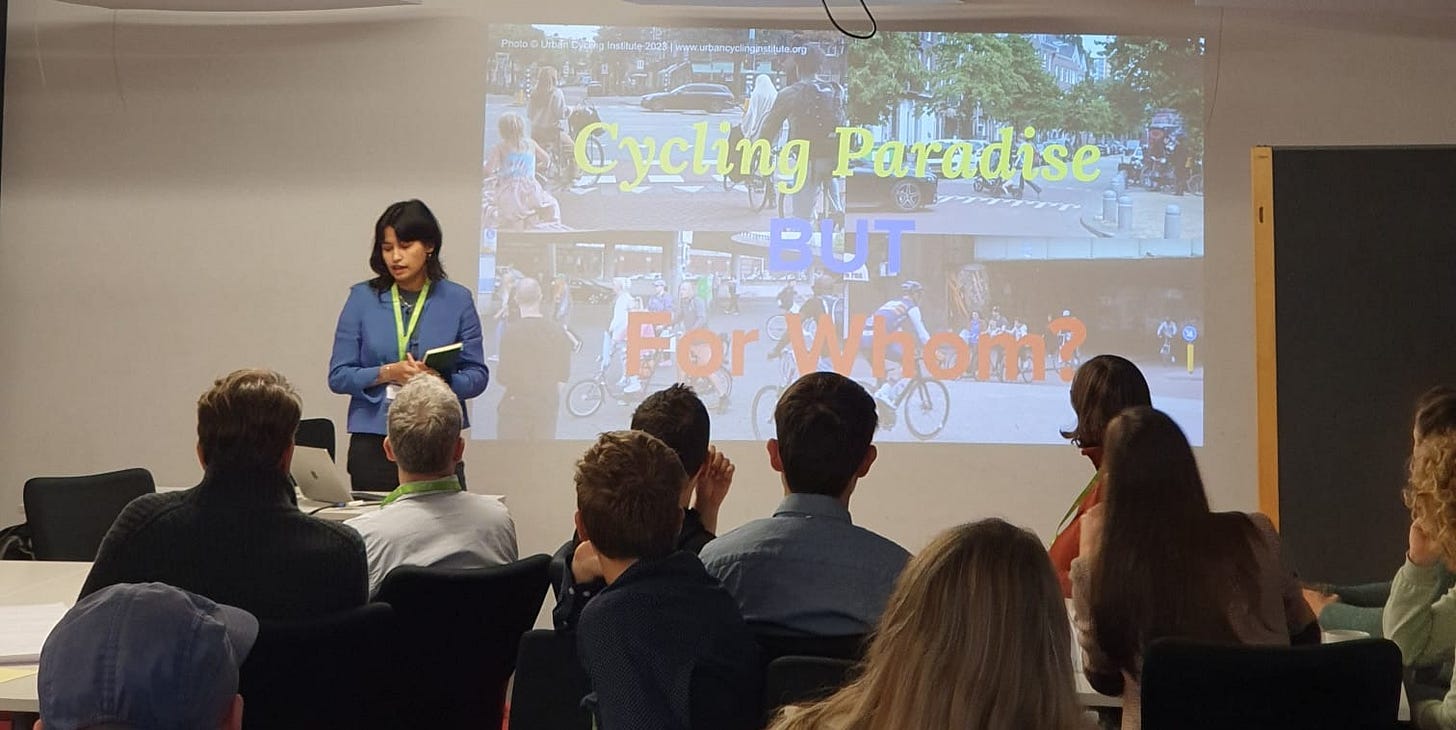Study Finds Barriers to Cycling in the World’s Cycling Capital
Research | Transport Exclusion | Amsterdam, Netherlands
In recent years, the push towards sustainable transportation has gained momentum as cities worldwide strive to reduce carbon emissions, combat climate change, and create healthier urban environments. From Paris to Bogotá, municipal councils and residents have embraced lower speed limits, expanded pedestrian zones, implemented care-blocks and bike-sharing programs as part of slowly transforming car-dominated streetscapes towards sustainable mobility systems.
Cycling, in particular, has been heralded and promoted as a cheap, sustainable and accessible mode of transport. But beneath this optimistic narrative lies a more complex reality: the green transition in transport systems risks deepening social inequalities, by privileging those who already have the resources, skills, and physical ability to adapt, and leaving marginalized communities behind. And further, do these inequities influence policies and institutions?
These emerging contradictions raise critical questions about transport exclusion, a phenomenon where systemic barriers such as cost, inaccessibility, and lack of representation limit access to mobility. And while the concept of transport exclusion seems to be gaining attention, the mechanisms that drive or exacerbate it remain poorly understood. Even less explored are the lived experiences of marginalized communities navigating the daily barriers of this mobility transition that is taking over cities all over the world. Who is left out of the sustainable mobility conversation?
An answer may be found in our recent study by Bárbara Oliveira Soares and Meredith Glaser, published in the Journal of Transport Geography, centering the voices of 22 community leaders representing marginalized communities including children, elderly, low-income individuals, disabled people, LGBTQ+, and communities of colour. By prioritizing their perspectives, the research offers a unique lens into the challenges of achieving a just mobility transition.
The research is situated in Amsterdam, a city globally celebrated for its cycling culture and progressive politics, seemingly an unlikely site for investigating transport exclusion. Yet, behind the endless rows of parked bikes and extensive cycling infrastructure, the study revealed often overlooked forms of exclusion.

Key findings: How do marginalised communities experience exclusion in their mobility practices?
While cycling is often framed as universally accessible, the study highlights three key dimensions of exclusion:
Embodied exclusion
Cycling is not just a physical activity, but an emotional and sensory experience that is tied to our identities, abilities, and capabilities. Fast-moving traffic, overcrowded cycling lanes and sensory overload can make cycling stressful and impossible, especially for more sensitive cyclists such as neurodivergent individuals and people with cognitive disabilities. Older and adaptive cyclists report feeling pushed out of the high-speed bike lanes designed for efficiency by focusing on fast-flowing, and prioritizing commuter cyclists, and often fail to accommodate those who ride more slowly, use adaptive bikes, or require more space. Overall, the physical and emotional toll of cycling in the city can make it an inaccessible or undesirable option for some.
Inequitable access to resources
Owning a bike isn’t enough. Financial constraints, language barriers, cultural norms and lack of cycling skills disproportionately exclude marginalized groups. As many low-income individuals cannot afford bicycles or repairs, bike kitchens, community-run workshops offering free or low-cost repairs and skills training, serve an important role in providing low-cost bike maintenance. Also, language barriers and digital exclusion prevent some from accessing municipal programs, such as subsidized cycling lessons and adaptive bikes. Specialised bikes, such as adaptive bikes for disabled riders are expensive and remain hard to access due to bureaucratic hurdles.
Lack of representation in planning and decision-making
Who decides what "good" cycling systems look like? The absence of diverse voices in urban planning and cycling policies results in a mobility system incapable of addressing the needs of all citizens. This epistemic injustice, namely the systematic dismissal of certain knowledge systems, perpetuates top-down and leads to a lack of diverse voices. Without meaningful representation, cycling policies and infrastructure designs often fail to account for the unique challenges faced by these communities.
Rethinking Just Mobility Transitions
Challenging the notion that "if you build it, they will come," this research underscores that achieving just mobility transitions requires more than infrastructure investment. Mobility justice demands a fundamental shift in governance, recognizing systemic barriers and actively addressing them.
This study contributes to ongoing discussions on mobility justice by shifting the focus beyond distributive justice (the fair distribution of resources) and incorporating epistemic (the recognition and inclusion of diverse knowledge systems), deliberative (the fair and inclusive participation of all stakeholders in decision-making processes), and procedural (the fairness and transparency of the processes used to make decisions) dimensions. Power imbalances within cycling shape mobility experiences, making cycling a marginalized or inaccessible choice for some groups.
A more inclusive approach demands stronger community involvement, addressing systemic barriers, greater accountability, and alternative knowledge-sharing practices.
What’s next? Towards truly just mobility transitions
As cities worldwide rethink their urban spaces, and strive for sustainable transitions, ensuring mobility justice remains critical in shaping equitable and accessible transport systems. Cities can become the stage for inclusive communities of care, achieved through spatial and mobility justice.
A crucial step involves rethinking for whom and by whom these mobility systems are designed and requires big gestures and radical choices. For example, shifting focus from work commutes to "mobilities of care", such as trips related to caregiving, healthcare, and daily errands, could foster more inclusive urban mobility. Cities like Vienna are already leading the way, by integrating gender mainstreaming into their mobility planning to ensure more equitable access.
Future research could explore how policymakers perceive and address transport inequities. Participatory methods such as ride-alongs and photovoice could provide deeper insights into the lived experiences of marginalized communities, helping to bridge the gap between policy and practice.
Other relevant resources
Our report on municipal challenges in inclusive cycling policy
Mimi Sheller on Mobility Justice
A practical approach to Mobility Justice by The Untokening
Written by , a PhD fellow at Urban Cycling Institute, edited by & .
Interested in writing or sponsoring an article? Send us a pitch at media@urbancyclinginstitute.org








Really appreciate this framing—and how it centres the lived experience of structural barriers, not just behavioural ones. As someone working across systems and governance, I’m especially interested in how these findings might inform broader city-making processes. How might we design policy and urban infrastructure not just to “encourage” cycling, but to structurally enable and prioritise it—particularly for marginalised groups?
Would love to see more work exploring the links between cycling justice, transport governance, and climate-adaptive urban planning!
This was an enlightening article, and I am thankful you shared it. We all seem to live in our own skins and are not able to even think outside that small box of personal experience. I knew about the expense of bikes but had not considered such things as people who have neurological differences. I hope this will prompt creativity to find alternative solutions.